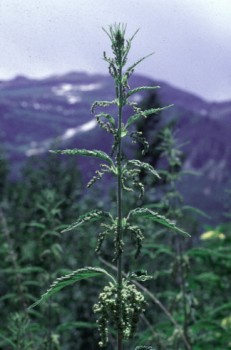Stinging nettle
|
|
| Stinging Nettle | ||||||||||||||
|---|---|---|---|---|---|---|---|---|---|---|---|---|---|---|
 Stinging nettle (Urtica dioica) | ||||||||||||||
| Scientific classification | ||||||||||||||
|
The Stinging nettle (Urtica dioica) is a herb native to Europe, Asia, and North America, the best known member of the nettle genus Urtica.
The taxonomy of stinging nettles has been confused, and older sources are likely to use a variety of systematic names for these plants. Formerly, more species were recognised than are now accepted. However, there are at least three clear subspecies, formerly classified as separate species:
- U. dioica subsp. dioica (European stinging nettle). Europe.
- U. dioica subsp. gracilis (Ait.) Selander (American stinging nettle). North America.
- U. dioica subsp. holosericea (Nutt.) Thorne (Hairy nettle). North America.
Other former species names that are now regarded as synonyms of U. dioica include U. breweri, U. californica, U. cardiophylla, U. lyalli, U. major, U. procera, U. serra, U. strigosissima, U. trachycarpa, and U. viridis. Other vernacular names include Tall nettle, Slender nettle, California nettle, and Bull nettle (a name shared by Cnidoscolus texanus and Solanum carolinense). Away from its native area, it has also been introduced to South America. The European subspecies has also been introduced into North America.
Euro_stinging_nettle.jpg
It is abundant in northern Europe, found widely in the countryside and readily colonising fertile nutrient-rich ground including urbanized areas. In North America it is widely distributed in the United States, where it is found in every state except for Hawaii, Arkansas, and South Carolina. However, in North America stinging nettles are markedly less common than in northern Europe.
The Stinging nettle is a herbaceous perennial, growing to 1-2 m tall in the summer and dying down to the ground in winter. The soft green leaves are 3-15 cm long, with a strongly serrated margin, a cordate base and an acuminate tip. Both the leaves and the stems are covered with brittle, hollow, silky hairs that contain formic acid as a defence against grazing animals. Bare skin brushing up against a stinging nettle plant will break the delicate defensive hairs and release the acid, usually resulting in a temporary and painful skin rash. One folk remedy for the sting is to treat the affected part with juice from the crushed leaf of a dock (Rumex obtusifolia), which commonly grows in association with nettles; it is not a very effective remedy.
Uses
Despite its sting, the nettle is a plant with many uses. It is recommended by the herbalists of many different cultures for a wide variety of purposes in herbal medicine. Cooking, crushing or chopping disables the stinging hairs, and the leaves are not only tasty, but high in nutrients. The young leaves are edible and make a very good pot-herb. A simple recipe is to gather the upper stalks including 3-4 pairs of leaves before the plants flower (using gloves), until one has enough to entirely fill a small saucepan. Fill the pan with cold water, and then put on a lid and drain off the water until all that remains is what is clinging to the leaves. Then put the pan on high heat and steam the leaves, shaking the pan occasionally, until all the leaves are wilted. The leaves can also be dried and used to make a tisane.
Nettle stems contain a bast fiber which has been traditionally used for the same purposes as linen, and is produced by a similar retting process. Nettles can also be used as cattle fodder; cows appear to find harvested nettles a delicacy.
Influence on language and culture
Illustration_Urtica_dioica0.jpg
In England the nettle is the only common stinging plant, and has found a place in several figures of speech in the English language. To "nettle" someone is to annoy them. Shakespeare's Hotspur urges that "out of this nettle, danger, we grasp this flower, safety" (Henry IV, part 1, Act II Scene 3). The common figure of speech "to grasp the nettle" probably originated as a condensation of this quotation. It means to face up to or take on a problem that has been ignored or deferred. The metaphor refers to the fact that if a nettle leaf is grasped firmly rather than brushed against, it does not sting so readily, because the hairs are crushed down flat and do not penetrate the skin so easily.
External links
- Plants for a Future database entry for Urtica dioica; comprehensive account with a long list of uses (http://www.scs.leeds.ac.uk/cgi-bin/pfaf/arr_html?Urtica+dioica)
- USDA plant description of Urtica dioica (http://plants.usda.gov/cgi_bin/plant_profile.cgi?symbol=URDI)
- image from 'Flora von Deutschland, Österreich und der Schweiz' (http://caliban.mpiz-koeln.mpg.de/~stueber/thome/band2/tafel_021.html)
- Contact-poisonous plants of the world (http://mic-ro.com/plants/)cs:Kopřiva dvoudomá
da:Stor Nælde (Urtica dioica) de:Große Brennnessel fr:Grande ortie et:Kõrvenõges pl:Pokrzywa zwyczajna sv:Brännässla
